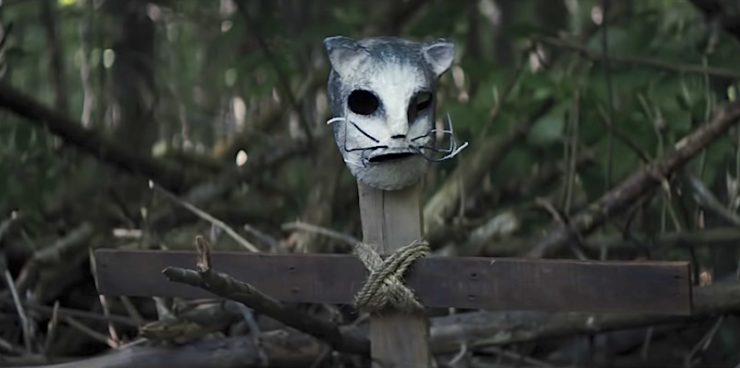The latest Pet Sematary is a fun update on the book and 1989 film (well, “fun” if you like horror, at least) with a few innovations I won’t spoil. Best of all, it commits to being a horror film: compact, gory in places and creepy in others, with just enough depth given to characters that you’re concerned for them, but without the need to justify its existence of its genre by over-intellectualizing.
If you’ve come to this movie you want to be scared and look at yucky things. This movie understands that, and will scare you and show you many yucky things.
The Creed family—Louis, Rachel, elder daughter Ellie (or, excuse me, “Ellie-Phant The Great and Terrible”), baby son Gage, and cuddly floof cat Winston “Church” Churchill—have all just left Boston to move into a giant creaky home in the country, seemingly without ever visiting it first, looking into its history, speaking to any potential neighbors, or even assessing exactly where the property lines are. (One hopes they did a quick Google of Ellie’s school district.) Louis is an ER doctor and has burned out the way movie doctors do, so he’ll be taking over a campus clinic and spending more time with his family.
This….does not go well.
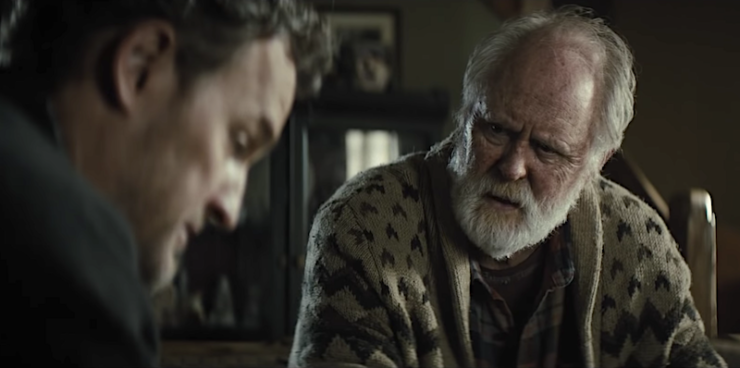
No sooner are they moved in than Rachel starts having incredibly vivid flashbacks to a traumatic incident in her childhood, and Ellie immediately finds the local pet cemetery, which is on the Creed’s property, which they never heard about from the realtor. And no, I am not letting this go. When they ask about it, their new neighbor Judson Crandall just says that their property line goes back “further than they’d ever want to go” and they both just drop it. Like, who the hell sold them this house? Don’t they have blueprints? Or an acreage listed on their mortgage? I’ve never bought a house but even I know that they should know this crap. What if they need to tear down a dead tree? Or dig a new well?
You want to talk to me about horror stories, try being in court with your neighbors for years because your cute little pre-fab writers shed encroached on their backyard.
The acting and directing are great across the board, creating a film that is much more self-assured and involving than the 1989 version. The directors, Kevin Kölsch and Dennis Widmyer, are good at giving us atmospheric shots full of fog and creaky old houses, and they know just how to frame an image for a jump scare. (I would say that they go to this well a little too often, however. It’s a good well, and Sadako’s down there somewhere probably, but come on.) While no one attempts the titanic Maine accent that Ed Gwynne perfected for the original adaptation, John Lithgow’s performance as Judson Crandall is a surprisingly raw and real wound in what could have been a schlocky horror movie. Both of the child actors are incredible, especially Jeté Laurence as Ellie, who goes through so much emotional range that I’m pretty sure she could do anything.
For those of you who know nothing of Pet Sematary, it’s a very personal riff on a zombie story. There is a place where the ground is “sour,” which means that the dead buried there don’t stay dead… but they’re also not necessarily the same when they come back to the world of the living. I once took a comics class with Scott Snyder and he said something that’s stuck with me: the scariest thing in the world is the idea of someone we love and trust turning against us. That’s the key to any good zombie or vampire story: this person looks like my child, but it isn’t my child.
The horror of the zombie or vampire story is that it takes a grieving person’s most profound wish—that somehow, miraculously, their departed loved one will walk back through the door—and twists it into the most gut-wrenching horror.
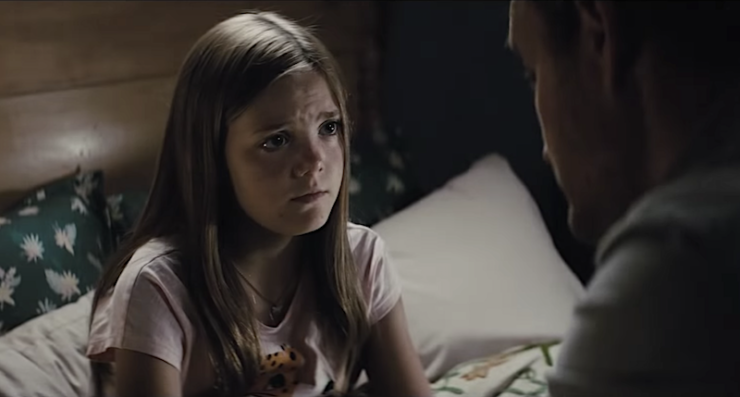
And where this latest adaptation of Pet Sematary does the best work is in letting the audience sit with that for a while. Each time there’s a tragedy, the survivors wait—by the phone for news, waiting for a funeral to end already so they can sob in privacy, or waiting for the footsteps of their loved one, returned to them.
Where this adaptation goes to another level is by circling the concept of death itself. Early in the film Louis and Rachel Creed have a spiky conversation with Ellie about death. She’s very much not okay with the fact that pets don’t live very long. What follows is a lovely and complex scene, where Louis tells his daughter that animals have faster metabolisms, death is natural, and when people and pets die they go into the ground to be part of the Earth. Then Rachel swoops in with the idea that the body goes into the ground, but that people and pets have souls that then go to Heaven, just like Nana Creed, who is watching over her as they speak. There is a tense standoff between the parents. Their cat, the cause of all of this, lashes his tail around and ignores them. Ellie is confused. Then they both rush back to a consensus that she shouldn’t worry about it cause she’s just a kid. Later the two of them argue about it, with Dad saying that Ellie is old enough to face death without any storytelling around it, and Mom reminding him that she’s not even nine yet.
Just in case you thought this was going to be a one-off moment, we’re treated to a drawn out and gruesome scene at Louis’ clinic when a college student is rushed in from a car accident. The victim’s wounds are among the most realistic I’ve seen in film, as are the reactions of the staff, with Louis, a former ER doc, diving into the fray and several of his less experienced nurses staring agog at the amount of blood a human body can produce. It underlines the darkness of the film, as the victim is a student, not even 20 years old, and the film allows this to fly in the face of the Creed parents’ comforting words without being too on-the-nose.
The running theme of the film is Louis’ struggle with the nature of death. Is there anything beyond biological function? Can the dead communicate with the living? Can they come back in some form, and if so, is that always the best outcome?
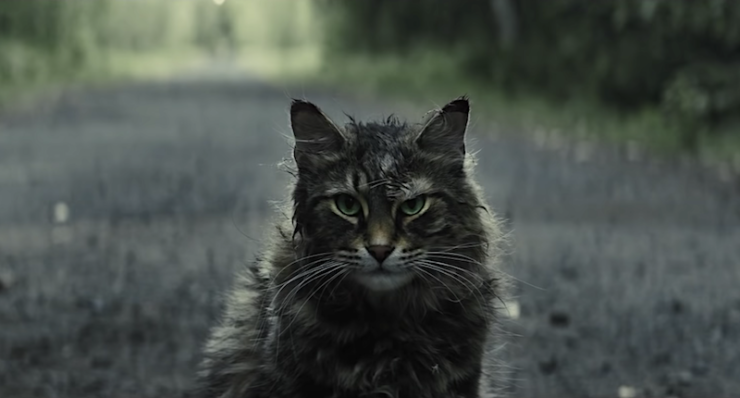
A note on the cat: this film contains some of the best cat acting I have ever seen committed to cinema. There were a team of cats playing Church Creed, and they were all a perfect mix of ‘adorable’ and ‘demon from Hell.’ Watching this film you will believe that a cat can scratch the ever-loving shit out of you, but that you’ll still be inconsolable when you think it’s run away. You will believe that a cat might be not simply a minion of Death Itself but rather some sort of malevolent enemy sent to destroy you and your family, but still, you really really don’t want to hurt his widdle paws by giving him a shot, cause isn’t he just the sweetest little Hell-Floof? Who’s a good Hell-Floof? Is it Church? It’s Church. What I’m saying is, these cats are all terrific, and they were rescues, and they’ve all been adopted, so way to go horror movie industry!
The way the film plays with spatial information is great, because like any good piece of nightmare logic, you sometimes just ARE somewhere else, with no memory of how you got there. So medicine cabinets and closets can become doors to other worlds, or to the past. There’s one set piece in particular where a walk into the woods seems to take us into another dimension, and we have no idea how much time has passed from the beginning of the walk to the end.
I was also pleased with how they updated the haunting itself, since the original book gets a little too, um, “Ancient Indian Burial Ground” for a modern audience. This adaptation skirts around that a bit and takes care not to vilify Indigenous people or make sweeping generalizations about cultures and religious beliefs. Which is nice.
And as far as where Pet Sematary stands on the continuum of current horror, I’d say it’s not quite as strong as Andy Muschietti’s adaptation of IT—which was one of my favorite films of last year—simply because we don’t get quite as much time for character development, and because Pet Sematary is set just sort of now-ish, where IT got to have fun with ’80s nostalgia. I actually noticed a lot of resonance with Mike Flanagan’s Haunting of Hill House series, particularly in a disturbing incident with a dumbwaiter. (I will never, ever live in a house with a dumbwaiter, because apparently they’re all evil.) And this latest version of Pet Sematary touches on The Shining, The Exorcist, and Evil Dead in some fun ways, while also being in active conversation with Mary Lambert’s 1989 version.
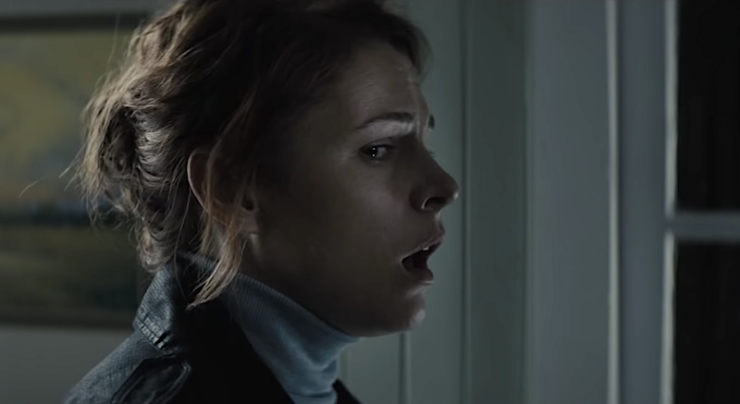
All of that said, there were a few aspects that didn’t work for me. I found the kids’ Pet Sematary much scarier than the haunted swampland beyond it. I thought that Rachel’s backstory was great, but maybe needed to be introduced a little earlier—and that goes double for Judson’s. We definitely get the sense that he’s been hollowed out by life, but I think the film should have given us more time with him, and shown us more of his past, to allow his life and mistakes to act as a counterpoint to the Creed family’s life. Giving us more of a sense of what was at stake for him would have made the movie even scarier.
But this is, finally, a great adaptation of what Stephen King himself considers his most frightening book. Pet Sematary meditates on death’s constant presence, on the raw howl of grief, on the transience of time and consciousness, and wraps all the big ideas and terrible emotions up in a creepy horror film that is, somehow, fun to watch.
Leah Schnelbach is happy that all five cat actors were adopted, but sad that all five cat actors were not adopted by her. Come talk about ailurophilia with them on Twitter!










